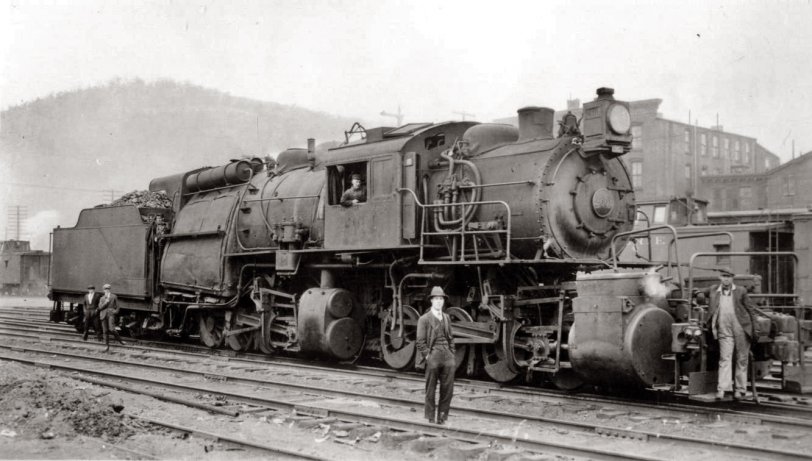


Framed or unframed, desk size to sofa size, printed by us in Arizona and Alabama since 2007. Explore now.
Shorpy is funded by you. Patreon contributors get an ad-free experience.
Learn more.

- Texas Flyer wanted
- Just a Year Too Soon
- WWII -- Replacing men with women at the railroad crossing.
- Yes, Icing
- You kids drive me nuts!
- NOT An Easy Job
- I wonder
- Just add window boxes
- Icing Platform?
- Indiana Harbor Belt abides
- Freezing haze
- Corrections (for those who care)
- C&NW at Nelson
- Fallen Flags
- A dangerous job made worse
- Water Stop
- Passenger trains have right of way over freights?
- Coal
- Never ceases to amaze me.
- Still chuggin' (in model form)
- Great shot
- Westerly Breeze
- For the men, a trapeze
- Tickled
- Sense of loneliness ...
- 2 cents
- Charm City
- What an Outrage
- Brighton Park
- Catenary Supports
Print Emporium
Erie 2601

Erie 0-8-8-0 Camelback locomotive at Port Jervis, N.Y., in 1911. The camelback design was unique in that the engineer sat in the tiny cab alongside the boiler, while the fireman worked at the usual spot behind the boiler. One of the main disadvantages was the obvious communication problem between engineer and the rest of the train crew while the engine was in operation. The Erie camelback mallets didn't last long, but smaller camelback locomotives survived well into the 1950's on roads like the Jersey Central. View full size.
There were three of these
There were three of these used for pusher service, not hump service. Only the ERIE had articulated camelbacks, no other road had them. They were all rebuilt later with their cabs at the back.
There were alot of camelbacks in the east and even some western roads had them: Santa Fe, Canadian Pacific, MKT, Chicago & Indiana Coalm, C&IE, to name a few.
There are more pictures all over the Internet, even a color painting.
An HO scale model just sold on Ebay for over $3000.00!
Only one
There was only one of this type of locomotive ever built, and it was used for only one thing. Hump work. Basically this engine spent its whole life pushing long trains up the hump of a yard where they would be gravity sorted. The idea behind the placement of the cab was more for visibility than anything. As for communication, the engineer and fireman used their own whistles to communicate between themselves. The engineer used the train whistle, the fireman had a lighter, lower whistle he used.
Erie Engine No. 2601 Derailed at Gulf Summit
In my wife's hometown paper (The Deposit Courier), the "Looking Back" section "100 Years Ago, 12 October 1910" says, "Erie engine No. 2,601, one of the largest engines in the world, was derailed at Gulf Summit Sunday night. It was pulling a train of about eighty cars and was running along at a fairly good rate of speed when suddenly it left the track. The big engine pounded along the rails for about 500 yards, cutting off the ends of the ties and tearing up the roadbed for a considerable distance. The Susquehanna wrecking crew was called and repaired the damage."
Erie 0-8-8-0- More photos (Link)
There are a few more photos of these engines at:
Erie 0-8-8-0 mallet
The "Mother Hubbards," sometimes called "camelbacks", common on railroads in the Anthricite (hard coal) region of Pennsylvania. IIRC there weren't many articulated locomotives built this way. I believe this particular type of locomotive was typically used in "helper service," pushing coal trains over the mountains.
The design comes from the need for a very large firebox on locomotives burning hard coal. Hard coal required a fairly thin fire to burn well, thus a large area was required to burn the amount of fuel required to generate enough steam. The fact that they burned the lowest quality of coal available didn't help!
This particular locomotive is interesting in that it is a true compound; notice the size of the front low pressure cylinders compared to the high pressure cylinders on the rear engine. This makes it a "true" Mallet.
It turned out that compounding didn't work as well as expected on railroad locomotives, and later articulated locomotives were built as "simple" engines.
I've never seen any of the larger Mother Hubbards in service, but I did see several of the smaller 0-6-0s and 0-4-0s in active service.
BTW & FWIW - in the 70's we lived in McCloud for four years. Beautiful country in that end of the state!
Erie 0-8-8-0 Camelback
At Port Jervis, N.Y., in 1911.I model trains in HO scale. I have never seen anything like this engine. I have seen 0-4-0, 0-6-0 and 0-8-0 camel engines, but never an articulated camel. I have a 2-6-6-2 articulated and have seen the 4-8-8-4 UP engines, but not this one. Anyone know where I could get more pictures of this engine?
Don Rowland - donhotrains@cinci.rr.com
[You could try contacting the person who posted this picture. First sign up for a user account, log in, click on his username, and then "contact." - Dave]
Photo's History?
What might you know of the photo's history? Interesting shot of a very rare locomotive.
Don Hall
Yreka, CA
























On Shorpy:
Today’s Top 5